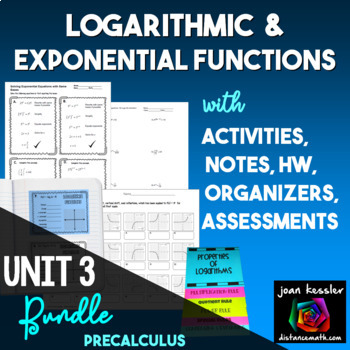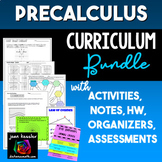Logarithmic and Exponential Functions Unit Bundle
- Zip
- Easel Activity
Products in this Bundle (14)
showing 1-5 of 14 products
Also included in
- This PreCalculus Curriculum Bundle with Notes, Organizers, and Activities, includes over 130 Resources which will enhance your lessons and engage your students with rigorous, challenging and fun lessons. It will also supplement your AP PreCalculus course. If you need help organizing the activitiesPrice $345.00Original Price $523.70Save $178.70
- This Exponential and Logarithmic Functions Super Bundle includes guided notes, activities, homework, quizzes, organizers, editable assessments, and more, PLUS Digital Activities and Digital Assessments, all of which will enhance your PreCalculus lessons and engage your students and give them the riPrice $67.95Original Price $96.00Save $28.05
- This PreCalculus Curriculum Bundle for 1st Semester includes Notes, Organizers, Assessments (some with digital versions), and Activities. There are 78 Resources which will enhance your lessons and engage your students with rigorous, challenging and fun lessons.This bundle includes activities such asPrice $225.75Original Price $299.40Save $73.65
Description
This bundle for Properties of Logarithmic and Exponential Functions is designed for PreCalculus Unit 3. Included are 12 resources with over 230 Task Cards, Interactive Notebook Pages, Stations, Flip Books, Worksheets, Games, Quizzes and HW assignments. These resources will also supplement your AP® PreCalculus Course Unit 2.
My many years of teaching experience has shown that students are engaged and succeed with varied lessons and activities. This unit will help you engage all your students with rigorous and fun activities while saving you time. Activity-based learning facilitates better understanding.
Included Topics:
- Introduction to Logarithms
- Condensing Logarithms
- Expanding Logarithms
- Logarithmic Equations
- Applications to Exponential and Logarithmic Functions
- Exponential Equations - No logs
- Exponential Equations with Logs
- Graphing Exponential and Logarithmic Functions
Note: This bundle does not include any Digital Products or FUN Notes but I will gladly custom bundle them for you. Here are some digital suggestions for you:
- Logarithmic and Exponential Functions Digital Activity Bundle
- More Digital Activities for PreCalculus and Trigonometry
- PreCalculus Fun Notes, detailed notes in a fun format
_________________________________________________________
You may also like:
★ Expanding Logarithms FUN Notes and Practice
★ Exponential Functions FUN Notes and Practice
★ Logarithmic Equations Maze plus HW
★ Condensing Logarithms FUN Notes
★ Logarithms End of Unit Assessment or Review
★ Bundle of Foldables and Interactive Notebook pages for Trig and PreCalculus
★ Unit 4 Trigonometric Functions Unit Bundle for PreCalculus and Trigonometry
★ Logarithmic Equations No Prep FUN Notes and Practice
_________________________________________
⇒ Please click here to follow my TpT store to hear about my freebies, sales, and new products. Did you know that you can earn 5% back towards future purchases by leaving feedback? Your feedback is greatly appreciated.
If you have any questions or comments please contact me by email me at: joan@joansworldofmath.com.
Connect with me:
✓ Sign up at Joan's World of Math to access my exclusive Free Resource Library
✓ Visit my Facebook Page
✓ Follow me on Instagram
LICENSING TERMS: The purchase of a license for this resource is for use by one teacher only for his or her students only. No part of this resource is to be shared with colleagues or used by an entire department, school, or district without purchasing the proper number of licenses. Please respect my hard work and do not share.
COPYRIGHT TERMS: ©2023 Joan Kessler (joansworldofmath™). This resource may not be uploaded to the internet in any form, including classroom/personal websites or network drives, unless the site is password protected and can only be accessed by students.
AP® is a registered trademark of the College Board® which was not involved in the creation of this product and does not endorse this product nor any that are linked on this page.






